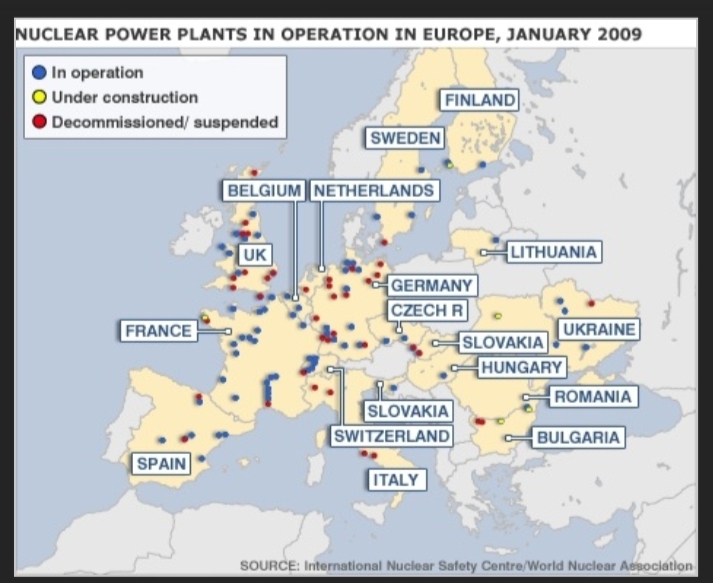유럽의 핵발전소 현황(2009)
The Current Status of Nuclear Power Plants in Europe (2009)
세르비아는 체르노빌 이후 핵발전소를 금지하는 법안을 제정하고 이를 오랫동안 운영해왔다. 유고슬라비아 시절부터 그랬던 것이다. 주변의 루마니아 헝가리 불가리아와는 다르다.
이와 관련된 정보와 문헌을 생명탈핵실크로드의 이승은 간사가 조사하여, 한국탈핵에너지학회(준)의 홈페이지에 게재하였다. 오늘은 이 자료를 소개한다.
Serbia has enacted and long operated legislation to ban nuclear power plants since Chernobyl. It has been the case since the days of Yugoslavia, unlike the surrounding Romania, Hungary and Bulgaria.
The information and literature related to this were investigated by Lee Seung-eun, secretary of the New Silk Road for Life and No-Nukes, and posted on the website of the Korean Society of Denuclear Energy(under organization). Today, I introduce this article.
“체르노빌 직후 세르비아가 채택한 원전금지제도”
2020년 2월 24일
현재 세르비아에는 원자력발전소가 없다.
“The anti-nuclear system adopted by Serbia shortly after Chernobyl.”
February 24, 2020
Currently, there are no nuclear power plants in Serbia.
이전에 Vinča Nuclear Institute는 소련이 공급한 두 개의 원자로(RA, RB)를 운영했었다. 그런데 1958년 10월 15일, 연구 원자로 중 하나에서 중대한 사고가 발생하여 6명의 근로자가 다량의 방사선에 노출되었고 그중 한 명은 바로 사망했다.
이후 원자력 연구 프로그램은 1968년에 끝났으며 원자로는 1984년에 꺼졌다.
Previously, the Vina Nuclear Institute had operated two Soviet-supplied reactors (RA, RB).,On October 15, 1958, a serious accident occurred in one of the research reactors, exposing six workers to a large amount of radiation, one of them died immediately.
Since then the nuclear research program ended in 1968 and the reactor was turned off in 1984.
1986년 체르노빌 사고 이후 원자력 사용의 금지에 대한 전국적인 캠페인이 진행되었고, 1989년 원자력 발전소 건설, 핵연료 제조 및 중고 핵연료 재처리시설을 금지하고 모든 활동을 범죄로 규정하는 법률을 규정하였다(구유고슬라비아).
A nationwide campaign was launched to ban nuclear power use since the Chernobyl accident in 1986. In 1989, they prohibited the construction of nuclear power plants, the manufacture of nuclear fuels, and reprocessing facilities for used nuclear fuels, and enacted the laws that criminalized all activities (in formerly Yugoslavia era).
유고슬라비아가 붕괴된 이후 1995년 3월 10일에 새로운 법이 채택되면서 핵 범죄와 관련된 논란이 있는 법령은 삭제했지만 이전의 유예권은 유지되었다.
대다수의 사람들과 정치인들이 여전히 원자력 사용에 대한 유예를 지지하고 있다.
After the division of the United States of Yugoslavia into several countries, with the adoption of the new law on 10 March 1995, controversial laws related to nuclear crimes were deleted, but the previous grace was retained. The majority of people and politicians still support a waiver on nuclear use.
즉, 세르비아는 체르노빌 이후 원전을 금지하는 법안을 제정하고 이를 오랫동안 운영해온 것이다. 유고슬라비아 시절부터 그랬던 것이다. 주변의 루마니아 헝가리 불가리아와는 다르다.
In other words, Serbia has enacted and operated a bill that prohibits nuclear power plants since Chernobyl, which has been in operation for a long time since the days of Yugoslavia. It is different from the surrounding countries, Romania, Hungary and Bulgaria.
2005년 세르비아 공화국 의회는 이 법률을 세르비아 공화국 영토에서 시행하고 있다(Official Gazette FRY 12/95 and Official Gazette RS 85/05).
내용은 원자력 발전소, 핵연료 제조 공장 및 핵연료 사용 후 핵연료 재처리 공장의 건설을 금지하는 것이다.
In 2005, the Serbian Republic Congress enforced this law in the territory of the Republic of Serbia (Official Gazette FRY 12/95 and Official Gazette RS 85/05).
The contents prohibit the construction of nuclear power plants, nuclear fuel manufacturing plants, and reprocessing plants of the used nuclear fuel.
그 결과 현재 세르비아 공화국의 원자력 발전소에 사용되는 원자력 연료를 관리하기 위한 모든 종류의 원자로 운영 및 시설에 대한 고려 또는 계획은 없다. 따라서 사용 후 핵연료 시설을 설치, 설계, 건설 또는 운영할 계획 또한 없다.
As a result, there is no consideration or plan for all types of reactor operations and facilities to manage nuclear fuel currently used in the nuclear power plants of the Republic of Serbia.,Therefore, there is no plan to install, design, construct or operate the used nuclear fuel facilities.
최근 러시아는 세르비아에 원자력 발전소가 아닌 연구용 원자로를 추진하고 있지만, 현재 규정에 따르면 세르비아에는 원자력 시설이 건설될 수 없다.
Recently, Russia has been pushing for a research reactor, not a nuclear power plant, in Serbia, but according to current regulations, nuclear facilities can not be built in Serbia.
다만, 다만 지난 몇 년간 1995년 법을 폐지하거나 최소한 10년으로 제한하자는 움직임도 있었다. 2018년 5월 Atom Expo 회의에서 정부 간 협약으로 서명된 내용에는 원자력의 이용에 대한 기술적 가능성에 대한 검토가 있었지만 그 실행은 불투명하다.
However, there has been moves to abolish the 1995 law or limit it to at least 10 years over the past few years. Signed by an intergovernmental agreement at the Atom Expo meeting in May 2018, there has been a review of the technical possibilities for the use of nuclear power, but its implementation is unclear.
++++++++++++++++++++++++
본문 및 관련되는 문헌을 소개한 본문은 다음 사이트에 있다.
The article that introduces the text and related literature is on the following site.
https://kpostnuclear.org/2020/02/23/%ec%b2%b4%eb%a5%b4%eb%85%b8%eb%b9%8c-%ec%a7%81%ed%9b%84-%ec%84%b8%eb%a5%b4%eb%b9%84%ec%95%84%ea%b0%80-%ec%b1%84%ed%83%9d%ed%95%9c-%ec%9b%90%ec%a0%84%ea%b8%88%ec%a7%80%ec%a0%9c%eb%8f%84/
세르비아 사례는 중요한 의미가 있다.
향후 학회에서는 세르비아 사례를 좀더 심층적으로 연구함과 동시에 핵발전소를 법으로 금지하고 있는 나라의 사례를 좀더 조사하고 연구할 필요가 있을 것이다.
The Serbian case has important significance for No-Nukes movement.
In the future, it will be necessary to study the case of Serbia more deeply and to investigate and study the cases of countries that prohibit nuclear power plants by law.

